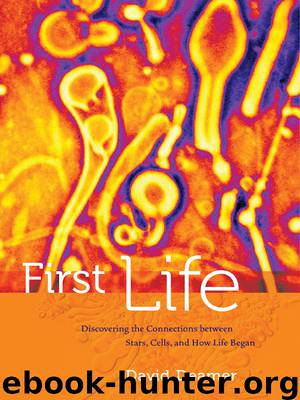First Life by Deamer David

Author:Deamer, David
Language: eng
Format: epub
Publisher: University of California Press
CONNECTIONS
The pathway to the first forms of life must have involved multiple self-assembly processes in which simple mixtures of organic compounds in solution were organized into more complex systems. The underlying forces of self-assembly include hydrogen bonding, electrostatic interactions, van der Waals interactions, and hydrophobic effects. Self-assembly processes are spontaneous, unlike energy-dependent covalent bond formation, but the self-assembly bonds are also weaker and more strongly influenced by environmental conditions such as pH, temperature, and ionic solutes.
In the laboratory, self-assembly can produce membranous compartments from simple amphiphilic compounds (like fatty acids) that were likely to have been available in the prebiotic environment. Such compartments would be essential for the origin of cellular life. However, those same organic compounds in a natural setting would have had a variety of possible fates other than what we observe in the laboratory, where pure compounds react in glass or plastic containers. For instance, we found that self-assembly of boundary structures cannot occur under hot acidic conditions, at least with a simple amphiphile such as myristic acid. Furthermore, if cations are present, such as the iron and aluminum in the Kamchatka pond or the calcium and magnesium in sea water, these cations will precipitate fatty acids as insoluble soaps and inhibit their ability to assemble into membranes.
These considerations are useful constraints on the conditions required for life to begin that were described in Chapter 2. They suggest that, from a biophysical perspective, the most plausible planetary environment for the origin of life would be a moderately acidic aqueous phase in the range of 70°C to 90°C, with divalent cations at submillimolar concentrations. This suggestion is in marked contrast to the view that life most likely began in a high-energy geothermal or marine environment, perhaps even the extreme environment of a hydrothermal vent. The reason a marine site for life's beginning has been favored is simply that fresh water would be rare on early Earth. Even with today's extensive continental crust, fresh water only represents about 1% of Earth's reservoir of liquid water. Another concern about a freshwater origin of life is that the lifetime of freshwater bodies tends to be short, on a geological time scale.
On the other hand, if the temperature and ionic composition of a geothermal spring or sea water markedly inhibit self-assembly processes, we might need to reconsider the assumption that life inevitably began in such environments. A more plausible site for the origin of cellular life may resemble Darwin's inspired suggestion of a warm little pond, such as freshwater pools maintained by rain falling on volcanic land masses, which fluctuate between dry and wet conditions. After the first forms of cellular life were established in a relatively benign environment, life would rapidly begin to adapt through Darwinian selection to more challenging conditions, including the extreme temperatures, salt concentrations, and pH ranges that we now associate with the limits of life on Earth.
Download
This site does not store any files on its server. We only index and link to content provided by other sites. Please contact the content providers to delete copyright contents if any and email us, we'll remove relevant links or contents immediately.
Man-made Catastrophes and Risk Information Concealment by Dmitry Chernov & Didier Sornette(4796)
The Revenge of Geography: What the Map Tells Us About Coming Conflicts and the Battle Against Fate by Kaplan Robert D(3620)
Zero Waste Home by Bea Johnson(3316)
In a Sunburned Country by Bill Bryson(2977)
COSMOS by Carl Sagan(2977)
Good by S. Walden(2940)
The Fate of Rome: Climate, Disease, and the End of an Empire (The Princeton History of the Ancient World) by Kyle Harper(2461)
Camino Island by John Grisham(2412)
A Wilder Time by William E. Glassley(2380)
Organic Mushroom Farming and Mycoremediation by Tradd Cotter(2324)
Human Dynamics Research in Smart and Connected Communities by Shih-Lung Shaw & Daniel Sui(2195)
The Ogre by Doug Scott(2141)
Energy Myths and Realities by Vaclav Smil(2083)
The Traveler's Gift by Andy Andrews(2032)
Inside the Middle East by Avi Melamed(1957)
Birds of New Guinea by Pratt Thane K.; Beehler Bruce M.; Anderton John C(1928)
Ultimate Navigation Manual by Lyle Brotherton(1786)
A History of Warfare by John Keegan(1742)
And the Band Played On by Randy Shilts(1643)
